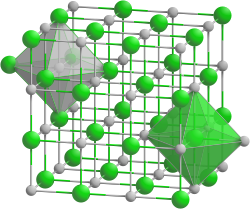Titanium (II) oxide
| Crystal structure | ||||||||||||||||
|---|---|---|---|---|---|---|---|---|---|---|---|---|---|---|---|---|

|
||||||||||||||||
| __ Ti 2+ __ O 2− | ||||||||||||||||
| Crystal system | ||||||||||||||||
| Space group |
Fm 3 m (No. 225) |
|||||||||||||||
| General | ||||||||||||||||
| Surname | Titanium (II) oxide | |||||||||||||||
| other names |
Titanium monoxide |
|||||||||||||||
| Ratio formula | TiO | |||||||||||||||
| Brief description |
gold colored solid |
|||||||||||||||
| External identifiers / databases | ||||||||||||||||
|
||||||||||||||||
| properties | ||||||||||||||||
| Molar mass | 63.87 g mol −1 | |||||||||||||||
| Physical state |
firmly |
|||||||||||||||
| density |
4.95 g cm −3 |
|||||||||||||||
| Melting point |
1770 ° C |
|||||||||||||||
| boiling point |
3227 ° C |
|||||||||||||||
| solubility |
|
|||||||||||||||
| safety instructions | ||||||||||||||||
|
||||||||||||||||
| As far as possible and customary, SI units are used. Unless otherwise noted, the data given apply to standard conditions . | ||||||||||||||||
Titanium (II) oxide is an inorganic chemical compound of titanium from the group of oxides .
Occurrence
Titanium (II) oxide occurs naturally in the form of the mineral hongquiite . Absorption bands of the compound were detected in the spectra of various stars.
Extraction and presentation
Titanium (II) oxide can be obtained by reacting titanium with titanium (IV) oxide at 1600 ° C.
It is also possible to produce by reducing titanium (IV) oxide with hydrogen at 2000 ° C. and a pressure of 130 atm .
properties
Titanium (II) oxide is a golden yellow solid and has a considerable range of homogeneity (TiO 1.2 - TiO 0.85 ). It dissolves in dilute hydrochloric acid or sulfuric acid with partial oxidation according to Ti 2+ + H + = Ti 3+ + 1/2 H 2 . It is a powerful reducing agent because it easily converts to titanium (IV) oxide . In this way it reduces water while forming hydrogen.
The compound has a crystal structure of the sodium chloride type (a = 418.2 pm ). Even with a stoichiometric composition, about 15% of the grid positions remain unoccupied and only when heated in a vacuum to 990 ° C do the vacancies begin to randomly swap places, so that X-ray structure analyzes show the typical scattering pattern of sodium chloride. At normal temperature, the stoichiometric compound is a metallic conductor with a monoclinic crystal structure. Overlapping the d orbitals of the titanium ions creates a metal band with delocalized d electrons. Probably the oxygen vacancies favor the overlap. When heated in air, the compound changes to other titanium oxides, depending on the temperature . This creates at 200-250 ° C , titanium (III) oxide and 350 ° C , titanium (IV) oxide .
use
Titanium (II) oxide is used in electrochromic systems.
Individual evidence
- ↑ a b c d Georg Brauer (Ed.), With the collaboration of Marianne Baudler a . a .: Handbook of Preparative Inorganic Chemistry. 3rd, revised edition. Volume II, Ferdinand Enke, Stuttgart 1978, ISBN 3-432-87813-3 , p. 1366.
- ↑ a b Datasheet Titanium (II) oxide, coating quality, granular, 99.5% from Sigma-Aldrich , accessed on May 19, 2013 ( PDF ).
- ↑ a b c W. M. Haynes, David R. Lide, Thomas J. Bruno: CRC Handbook of Chemistry and Physics 2012–2013 . CRC Press, 2012, ISBN 978-1-4398-8049-4 , pp. 4–96 ( limited preview in Google Book Search).
- ^ A b G. Singh: Chemistry Of D-Block Elements . Discovery Publishing House, 2007, ISBN 978-81-8356-242-3 , pp. 107 ( limited preview in Google Book search).
- ^ Dale L. Perry: Handbook of Inorganic Compounds, Second Edition . Taylor & Francis US, 2011, ISBN 978-1-4398-1462-8 , pp. 434 ( limited preview in Google Book search).
- ↑ Mindat: Hongquiite: Hongquiite mineral information and data.
- ↑ HM Dyck, Tyler E. Nordgren: The Effect of T [CLC] i [/ CLC] O Absorption on Optical and Infrared Angular Diameters of Cool Stars. In: The Astronomical Journal. tape 124 , no. 1 , 2002, p. 541-545 , doi : 10.1086 / 341039 (English).
- ^ Neill Reid's Homepage: Spectral classification of late-type dwarfs
- ^ A b François Cardarelli: Materials Handbook: A Concise Desktop Reference . Springer, 2008, ISBN 978-1-84628-669-8 , pp. 617 ( limited preview in Google Book search).
- ↑ Zhong Lin Wang, Zhen Chuan Kang: Functional and Smart Materials: Structural Evolution and Structure Analysis . 1998, ISBN 0-306-45651-6 , pp. 74 ( limited preview in Google Book search).
- ↑ Erwin Riedel, Christoph Janiak: Inorganic Chemistry . Walter de Gruyter, 2011, ISBN 3-11-022566-2 , p. 792 .
- ↑ Catherine E. Housecroft: Inorganic chemistry. [Main volume] Pearson Education, 2005, ISBN 0-13-039913-2 , pp. 601 ( limited preview in Google Book search).

